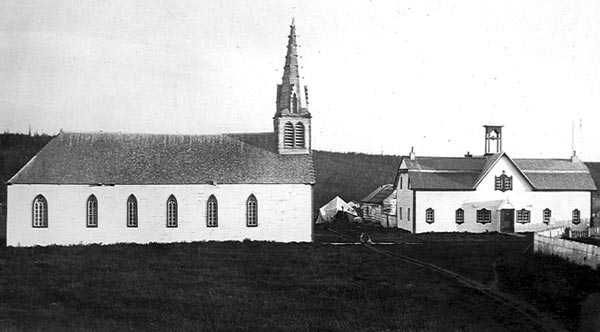The mission of Our Lady of Good Hope was founded by Father Henri Grollier in August 1859. It is situated on the right bank of the Mackenzie River beyond the 66th degree of North latitude, near the Arctic Circle and about 5,000 kilometres from Saint-Boniface. Father Grollier had set out from Great Slave Lake, about 1,600 kilometres to the south and he had met with the Amerindians in the forts along the river in the hope of reaching them ahead of the Anglican ministers. The Amerindians who frequented this fort were mainly belonging to the Hare tribe.

Father Grollier died at Fort Good Hope in 1864. He was 38 years of age. He was replaced by Father Jean Séguin who remained at Good Hope mission from 1861 to 1901 together with Brother Joseph P. Kearney who lived at Good Hope for 58 years, from 1861 to 1918.
The missionaries in Good Hope visited several other missions, especially Immaculate Heart of Mary at Great Bear Lake, Saint Therese at Fort Franklin, Saint Francis Xavier at Fort Anderson, The Holy Name of Mary at Fort MacPherson where Father Grollier met the Inuits in 1860, Saint John at Fort Yukon, etc.
At the end of 1861 and the beginning of 1862, Bishop Grand a few months with the missionaries of Good Hope. In his diary, on November 15, 1861 he gives a deion of the mission: “The house is built of timber, 22 foot long by 18 wide. It serves simultaneously as church, exercise room, recreation room, refectory, sleeping quarters, and kitchen. It is a real omnibus. It is also used a s a workshop… The beds do not occupy much space. They are blankets which we spread on the floor each evening and fold up in the morning.”
At the beginning this mission was part of the Apostolic and religious Vicariate of Saint Boniface. It was then changed to the Vicariate apostolic of Athabaska-Mackenzie on May 13, 1862 and the mission vicariate of the same name on November 30, 1864. Both the Vicariate apostolic and the mission vicariate assumed the name of Mackenzie in 1901.
According to a report by Father Aloyse Brettar, in 1966, the population was then 327, nearly all of whom were Catholics (276 Amerindians, 24 Métis, and 27 Whites). The church celebrated its centenary in 1966 and was still “in good shape”.
The Oblates left this mission towards 1900. It was then part of the Grandin Province,
Yvon Beaudoin , o.m.i.
